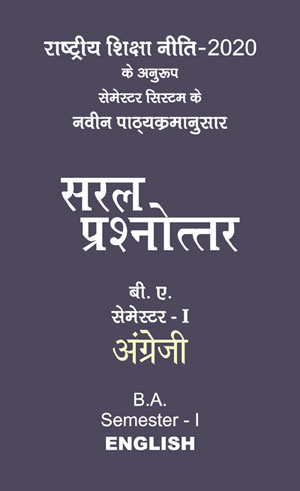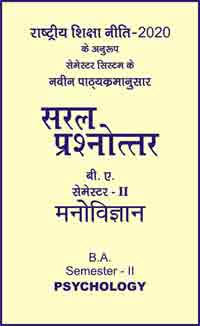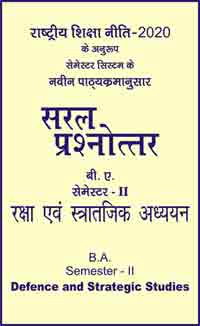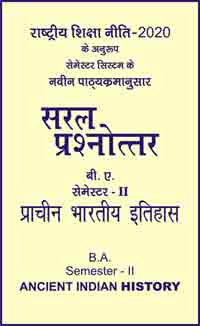|
बी ए - एम ए >> बीए सेमेस्टर-1 अंग्रेजी बीए सेमेस्टर-1 अंग्रेजीसरल प्रश्नोत्तर समूह
|
5 पाठक हैं |
|||||||
बीए सेमेस्टर-1 अंग्रेजी के प्रश्नोत्तर
9
Under The Banyan Tree -R. K. Narayan
Question- What is the summary at the story 'Under The Banyan Tree' by R. K. Narayan?
Ans-
"Under The Banyan Tree" the title story in R. K. Narayan's collection "Under the Banyan Tree', and other stories (1985), appeared originally in his earlier volume, 'As Astrologer's Day and other stories (1947).
The story begins in a small village, Samal, with a population of less than three hundred; it was very filthy. It was so much caught up in dirt and was so ill-planned that even social reformer could feel depressed on looking at its hopeless condition. Its tank would provides water for drinking, bathing and washing the cattle but at the same time it was the mother of numerous serious diseases like malaria and typhoid. The village nad crooked and winding lanes and the backyard of every house had puddles of stagnating water. People were insensitive to their surroundings, perhaps because of Nambi, the prepetual enchanter who made them forget about their sordid reality by transporting them to a colourful world of adventures and wealth through the stories he told them. He was an extraordinary story teller whose age was very difficult to estimate. If anyone asked him about his age, he would refer to some old famine or an attack from outsider or the buildings at a bridge. Although he was illiterate, he had the gift at creating fabulous and entertaing stories that could fascinate anybody.
The front part of a little temple was the humble abode at this story teller Nobody knew how he came to make that temple his home and his place of worship. He did not have many belongings. He had a couple of dhoties and upper clothes and a broom to sweep the temple. There was a banyan tree in front of the temple where Nambi used to spend most of his time. People would come in large numbers at this banyan tree in the evenings and got entertained by Nambi's observations and anecdotes. Sometimes he would say that he had to meditate and contemplate so that the Goddess could bless him with a new story to tell. He assured the people that his stories were a gift from the Goddess and did not float in air.
The villagers used to worship at the temple on Friday evenings Nambi would lit several mud lamps and arrange them around the inner part of the temple where the idol at the Goddess was placed. He would decorate the idol of the Goddess Shakti on these occasions he would act as the priest and after fruits and flowers to the Goddess. When Nambi had a story to tell, he would lit a lamp and place it in a hollow space in the trunk at the banyan tree. The villagers would notice the lamp and know that their enchanter had another story to entertain them with. They would hurry up with their meals and gather under the banyan tree. The story teller would come after his contemplation, forehead smeared with ash and vermillion and sit on a stone platform in front of the temple. Nambi used to start his story in an interesting way by pointing towards a vague and distant spot. He would begin his story by asking a question. He would talk about the great Kings and their palaces,capitals etc. He would describe in details the pictures and trophies hung on the walls of the palace and sing the songs sung by the musicians of the Kings. He used to build the story on an extened scale which required many days to tell it fully. The first day was usually taken up in describing the setting of the story. In the next sessions Nambi's voice would rise and fall while narrating the rest of the story where common and aristocratic people, heroes, villains and supernatural powers justled with one another in the fantastic world created under the banyan tree. The simple villagers would get swayed emotionally with the incidents of the story. After the story session, the whole audience used to go inside the temple and prostrate themselves before the Goddess.
Usually, with every new moon Nambi was ready with a new story. He never repeated the same type at the story. This process went on smoothly for years. But one day an unusual things happened. He lit the lamp and his fans gathered to listen to him. He started telling the story of King Vikramaditya and one of his ministers when all of a sudden to paused, repeated the same sentence but found his words turning into unclear sounds. He thought for a while and prayed to the Goddess that he should not fumble and waver in his art. He could not understand why all of a sudden he forget the story. It was an experience which was humiliating and painful for Nambi. The villagers who were eagerly waiting for his next words were also greatly puzzled. As the time passed they started chattering and after sometime silently slipped a way
Nambi was dumbstruck. He realized that he had grown old. He found that Mari, his old friend, was still sitting there while others had left Nambi told him in a disappointed strain that his head had refused to be his servant and had become disobedient and disloyal.
Next day he lit the lamp again and villagers assembled faithfully. Nambi had prayed the whole day to the Goddess not to leave him in lurch again. He started the story and went on for an hour. He thanked the Goddess for not deserting him and continued his story. But after a few minutes, he paused and groped for words but failed to start again. The audience got up silently and went home. Nambi did neither curse nor blame the villagers as they would not wait for hours for the story. After two days he started another story which lasted only for a few minutes and the gathering again with drew people started ignoring the lamp and Nambi wished that he would have died earlier. However he shut himself into the inner part of the temple, ate little food and meditated in a motionless manner.
When the next moon appeared Nambi lit the lamp again. Only a handful of the villagers turned up. They waited for others and finally the story teller refused to narrate the story till the whole village gathered. On the next day Nambi personally went around the village to tell the people that he had a wonderful story to tell and everyone should hear it. The villagers felt happy to know that the enchanter had regained his powers and a large crowd. assembled under the banyan tree. But instead at telling a story, Nambi announced that he had became a dull and foolish old man who had lost his gift of storytelling. He added that the Goddess was the giver and taker of this gift. He told them that the jasmine was useless without its smell and there was no use of the lamp when all of its oil was gone. He told that these were his last words and that was his greatest story. After that the storyteller got up and went inside the sanctum.
The surprised villagers could not understand it and when some of them entered the temple and asked him if he had nothing more to say, Nambi remained silent and indicated through gestures that he had spoken his last words. After this, he would walk into any cottage he liked and sit silently for food and walk away as soon as he had finished his food. He did not demand anything more from them. There was an utter silence in the rest of the life of the storyteller. The writer, thus shows how the artist loses is powers one day and his art becomes stale and lifeless. A wise artist should stop when such a point is reached in his career.
|
|||||
- Question- Discuss Sri Aurobindo's contribution to Indo-Anglian poetry.
- Question- Discuss Sri Aurobindo as a mystic poet.
- Question- "Tagore is a lyric poet par excellence." Comment.
- Question- "Tagore is not a poet of Bengal, but of India and the world." Discuss.
- Question- Write a note on life and works of K. S. Venkataramani.
- Question- Describe Venkataramani's reflection on village life which he presented in his novels.
- Question- Write the life and writing style of Bhabani Bhattacharya.
- Question- Write about Bhattacharya's concept of Fiction.
- Question- Consider R. K. Narayan as a novelist.
- Question- Describe Indianess in R. K. Narayan's novels.
- Question- Write a note on Mulk Raj Anand's place in English Literature.
- Question- Write a note on the main influences on Mulk Raj Anand.
- Question- What is Mulk Raj Anand's contribution to the development of Indo-Anglian fiction?
- Question- What are the general themes of the novels of Mulk Raj Anand?
- Question- Write a short note on Mulk Raj Anand as a social critic of downtrodden society.
- Question- What is the contribution of Mulk Raj Anand to Indian English Literature?
- Question- Write a detailed life-sketch of Sarojini Naidu. Also describe in her works and contribution towards Indian Writing English.
- Question- Write life and career details of Kamala Markandaya in detail.
- Question- Write a note on the contribution of Kamala Markandaya towards the growth of Indian English Literature.
- Question- Write a comment on Kamala's 'Art of Narration".
- Question- Write a note on life and works of Nayantara Sahgal.
- Question- Write a list of the works of Nantara Sahgal?
- Question- Which is the last novel of Nayantara Sahgal?
- Question- Explain Plot in a Short Story.
- Question- What is characterization in a short story? Discuss the types & importance of characterization.
- Question- What is the meaning of Narrative Techniques? Explain types of narrative technique with examples.
- Question- Write a note on the Narrative structure and its types. Discuss in brief.
- Question- What is prose and what types of prose are found in English Literature?
- Question- What is short story?
- Question- What is an essay?
- Question- Discuss novel.
- Question- What is autobiography?
- Question- What is biography?
- Question- What is play?
- Question- What is Travelogue ? Mention two books that belong to this class of literature.
- Question- Discuss Pamphlet.
- Question- What is biography? Name two famous biographies in English.
- Question- What is an informal essay? Who is a well-known informal essayist of English Literature?
- Question- Distinguish between formal and personal essay. Give examples.
- Question- How would you distinguish between early eighteenth century and early nineteenth century style in literary essay writing?
- Question- What is an autobiography? How is it different from a biography?
- Question- What is theme? Explain in detail.
- Question- What do you know about Sentence Pattern?
- Question- What do you know about Imagery and Explain the types of Imagery?
- Question- What is Tone or Mood? Elaborate it in detail.
- Question- What is the definition of 'Point of View' ?
- Question- What do you understand by Humour ? Also write the characteristics and kinds of it.
- Question- What is the meaning of Analogy?
- Question- What do you mean by Anecdotes?
- Question- What do you mean by Aphorism?
- Question- What are the definitions of Inversion?
- Question- How do you define a theme?
- Question- What is the theme in a story?
- Question- What are the main themes?
- Question- What is imagery and its example?
- Question- Define Pathos in literature.
- Question- What are the origins of Pathos ?
- Question- What is Pathos?
- Question- What are the models of humour?
- Question- What do you mean by Antithesis?
- Question- What do you mean by diction?
- Question- O. Henry's The Last Leaf is the story of perseverance. Discuss.
- Question- Describe the character of Sue in the story 'The Last Leaf.
- Question- How does Johnsy deals with her illness?
- Question- Explain the theme and the title of the story "The Last Leaf."
- Question- Attempt a detailed character sketch of Iona.
- Question- Comment on the setting, theme and tone of the story.
- Question- What message does the story 'Lament' provide?
- Question- Analyse the story with reference to its relevance in the present context.
- Question- Comment on the symbolism in the short story "The Lament'.
- Question- Who is Iona ? What impression of his character do you get from the story?
- Question- Why is it important for Iona to be able to tell someone about his son's death?
- Question- Comment on the indifference that meets Iona's attempts to share his grief with his fellow human beings.
- Question- How does the horse serve as a true friend and companion to Iona ?
- Question- Empathy and understanding are going out of modern society. The individual experiences intense alienation from the society around him or her. Comment.
- Question- Explain in detail the life and work of Guy de Maupassant.
- Question- What is the summary of the story The Terror' by Guy de Maupassant?
- Question- What is the theme of the story The Terror' and describe it in your own words?
- Question- Write the Introduction of the story The Terror'.
- Question- What is the point of view in this story "The Terror' by Maupassant?
- Question- What is meaning of 'Fear' and 'Sense' in this story The Terror?
- Question- What is in Mental Disorder in this story The Terror'?
- Question- The writer presents his attitude towards women in this story "The Terror'. Explain it.
- Question- What is the summary of the story The Barber's Trade Union' by M. R. Anand.
- Question- Who is the Protagonist of the stoey The Barber's Trade Union"?
- Question- Why was Chandu not good at doing sums at school?
- Question- Why did the narrator's mother constantly dissuade him to play with Chandu?
- Question- What is the meaning of Trade Union?
- Question- What is the summary at the story 'Under The Banyan Tree' by R. K. Narayan?
- Question- Describe the village Somal.
- Question- Who is Nambi in the story 'Under the Banyan Tree' ?
- Question- What do you understand by 'enchanter"? Why does the author call Nambi an 'enchanter"?
- Question- What is irony? How does Narayan use it in this story?
- Question- "It was story building on an epic scale." What do you understand by this statement? Elaborate.
- Question- Why does Nambi says, "...... Age, age. What is my age? it has come on suddenly ?"
- Question- Describe Nambi's life after he stops telling stories? Do the villagers reject him?
- Question- Explain "terrible sense of his insignificance" which Ravi feels at the end of the story. What lesson has he learned about life?
- Question- Discuss the various themes in the story.
- Question- Comment on the plot of the story.
- Question- Attempt a detailed character sketch of Ravi.
- Question- What do you know about the setting of the story, 'Games At Twilight'?
- Question- Who is Raghu ? What do you assess about his character?
- Question- Describe the garden in which the children are playing hide and seek.
- Question- What are your impressions of the following children from the first section of the story?
- Question- How is the shed described? Why are these details important to understanding Ravi's feelings?
- Question- How did Ravi lose without being caught?
- Question- Analyse the theme of Bacon's eassy 'Of Studies.'
- Question- Write an essay on Bancon's prose style.
- Question- Critically appreciate Bacon's 'Of Studies'.
- Question- What message does Bacon try to put across in the essay 'Of Studies'?
- Question- The essays of Bacon are concerned only with worldly wisdom and the art of success. Discuss.
- Question- What type of books are recommended by Bacon for studies?
- Question- What are the bad effects of studies according to Bacon?
- Question- How does Bacon justify that various defects of mind can be cured by particular studies?
- Question- Who is the author of 'Of Studies'?
- Question- According to Bacon what is the use of studies?
- Question- How studies are used by different kinds of people?
- Question- Bacon says 'Studies pass into character', explain it.
- Question- Give two features of Bacon's style.
- Question- Quote one sentence Bacon's 'Of Studies', that you like most.
- Question- Ennumerate the advantages of reading books.
- Question- Give two reasons why do you like an essay.
- Question- How, according to Bacon, do history, poetry, mathematics, natural philosophy, moral philosophy and logic and rhetoric help one to improve one self?
- Question- Write a brief note on the life and work of Charles Lamb.
- Question- Give a critical estimate of Lamb as an essayist.
- Question- What are the salient features of Lamb's prose-style?
- Question- Discuss autobiographical element in the essays of Lamb.
- Question- Write a note on Lamb's as a writer of humour and pathos.
- Question- Write a note on Lamb as a lover of peace.
- Question- What happened when Lamb awakened from his dream?
- Question- How does Charles Lamb present his brother John Lamb?
- Question- Examine in short "Dream Children" as a specimen of Dream Literature.
- Question- Analyse the striking qualities of Addison as a satirist ?
- Question- Compare Addison and Steele as critics of the life and manners of their age.
- Question- Write a note on Addison's prose style.
- Question- Briefly analyse Addison's prose style.
- Question- Who was Sir Roger?
- Question- Why is said that Sunday clears away the rest of the whole week?
- Question- Write a note on use of wit, irony and fancy in the essay of Addison?
- Question- What is the significance of a Country Sunday?
- Question- Give a brief note on Addison as a innovator of periodical essays.
- Question- Who is the author of the essay 'Sunday in the Country'.
- Question- Give an introduction of 'Profession For Women' by Virginia Woolf.
- Question- Critical appreciation to 'Profession For Women' by Virginia Woolf.
- Question- What are the main obstacles in Profession For Women' by Virginia Woolf?
- Question- What is the main point of the essay Profession for Women'?
- Question- Describe the full life detail of A.P.J. Abdul Kalam.
- Question- Write about the famous book "Ignited Minds" of Kalam and its qualities.
- Question- What is an early life and education of Amartya Sen?
- Question- What do you know about Amartya Sen's Career?
- Question- What do you know about Amartya Sen's personal life?
- Question- Write about Amartya Sen's award and honours.
- Question- Give an Introduction to The Argumentative Indian', written by Amartya Sen, in your words.
- Question- How does Amartya Sen portray Tagore in his essay Tagore and His India"?
- Question- What did Rabindranath Tagore do for India?
- Question- What do you mean by Power Point Presentation?
- Question- What are benefits of Power Point?
- Question- Discuss power point presentation.
- Question- What is presentation? How are they created?
- Question- Give the importance of letter writing. What are the types of letters? What are the qualities of a good letter?
- Question- Make an application to the Principal P. P. N. College Kanpur for giving you a full concession in fee.
- Question- Write an application to the Principal of your college requesting him to allow you to change one of your subjects.
- Question- Write an application to the District Supply Officer for supplying building material.
- Question- Write an application to the Principal of your college requesting him to grant you leave for four days so that you may attend the marriage ceremony of your elder sister.
- Question- Discuss personal letter. Name the parts of it.
- Question- What do you understand by an Inquiry letter?
- Question- What is complaint letter and also describe the format and examples of it.
- Question- Describe Right to Information letters in detail and also tell the steps to file it.
- Question- Write a note on enquiries, quotations and orders.
- Question- Write a note on complaint and adjustment letter.
- Question- Give the form and contents of an application letter.
- Question- Discuss Resume writing.
- Question- Write down the do's and dont's while preparing your resume.
- Question- Write a note on covering letter of resume.
- Question- Write short note on the following- (a) Bio-data (b) Application blanks.
- Question- Pen down a model of an application to the Vice Chancellor of a University for the post of Assistant Professor of Education.
- Question- Write a detailed note on Online Writing.
- Question- What is a Blog?
- Question- What are the purpose of a blog?
- Question- What is Blog Structure?
- Question- What is blogging?
- Question- What is Content Writing?
- Question- Write the types of Content Writing.
- Question- What is the basics of content writing?














